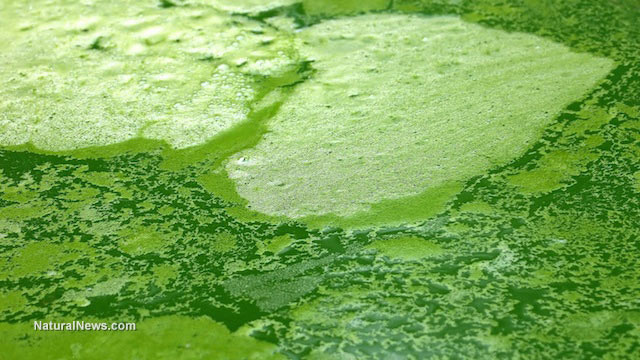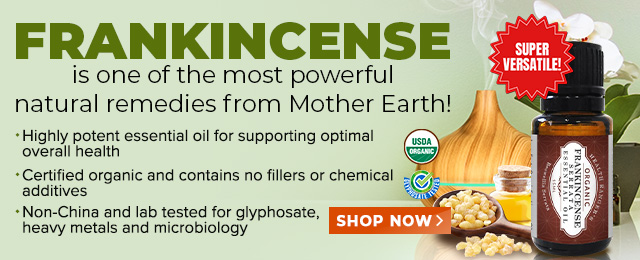Monsanto's glyphosate poisoning Lake Erie, causing toxic algae blooms responsible for killing fish and contaminating drinking water
Friday, July 15, 2016 by: Jonathan Benson, staff writer
Tags: glyphosate contamination, Lake Erie, toxic algae

(NaturalNews) America's Great Lakes are in dire straits. Elevated levels of phosphorus are triggering devastating algae blooms that are tainting drinking water supplies and killing fish in record numbers, and researchers from Ohio Northern University (ONU) say there's one main cause of all this destruction: the glyphosate in Monsanto's Roundup herbicide.
It's known more precisely as dissolved reactive phosphorus, or DRP, a waste byproduct of industrial agriculture that's literally pouring into the Lake Erie basin from farms located primarily in the Maumee watershed area of Western Ohio. Scientists have long wondered where all this phosphorus is coming from, but it's now apparent, based on more than 40 years of observation, that chemical agriculture is to blame.
Ever since the early 1970s – right around the time when glyphosate first emerged as the herbicide of choice for factory farmers – water quality reports have shown escalating levels of phosphorus in Great Lakes waters. They dipped for a short time, only to come back with a vengeance in the mid-1990s, when Roundup Ready crops were introduced by Monsanto.
Today, more than 95 percent of soybeans and more than half of all corn planted in the U.S. is Roundup Ready, meaning these crops can tolerate spraying of glyphosate without dying. Farmers have been using increasingly more Roundup as a result, and data extrapolations show that these increases in herbicide use directly coincide with increases in DRP in the Great Lakes.
"These crops that are able to grow in the presence of glyphosate have really kind of started to take over, to the point where we're washed in Roundup," admits Christopher Spiese, a chemist at ONU who held nothing back concerning the dangers of glyphosate at a recent conference looking at the possible causes of the Great Lakes phosphorus phenomenon.
Every acre of Roundup Ready crops produces 1/3 pound of polluting phosphorus, scientist admits
With the help of several collaborators, Spiese decided to take a closer look at the DRP runoff situation to see if glyphosate really is the culprit. He and his team looked at the amounts of DRP present in relation to herbicide-tolerant crop acreage throughout the Maumee watershed. They also evaluated how much phosphorus is likely to be produced by a given amount of glyphosate, measuring this amount in relation to total estimated herbicide use throughout the region.They found that, just as suspected, glyphosate is a major, if not sole, contributor to DRP pollution in Lake Erie and beyond. It turns out that glyphosate not only contains, but also bears a chemical structure that closely resembles phosphorus, which means it most certainly is a clear and present danger to our Great Lakes.
"For every acre of Roundup Ready soybeans and corn that you plant, it works out to be about one-third of a pound of P [phosphorus] coming down the Maumee," Spiese says.
The problem is now so out of control that Ohio Governor John Kasich had to declare a state of emergency back in 2014, after at least half a million Ohio residents were left without clean drinking water due to phosphorus pollution in Lake Erie. It's the job of the Environmental Protection Agency (EPA) to be looking out for the interests of the people and preventing this type of thing from happening in the first place, but this federal agency seems to be missing in action, and the people now have to fend for themselves.
Clean drinking water is becoming increasingly hard to come by, which is why companies like Berkey offer advanced filtration systems that purify water of phosphorus, fluoride and many other chemical contaminants that threaten you and your family. Learn more about the benefits of this amazing system here.
Sources for this article include:
SustainablePulse.com
NaturalNews.com
Glyphosate contamination at FETCH.news
Get independent news alerts on natural cures, food lab tests, cannabis medicine, science, robotics, drones, privacy and more.
More news on glyphosate contamination
Take Action: Support Natural News by linking to this article from your website
Permalink to this article:
Embed article link: (copy HTML code below):
Reprinting this article:
Non-commercial use OK, cite NaturalNews.com with clickable link.
Follow Natural News on Facebook, Twitter, Google Plus, and Pinterest
- Newly released JFK files reveal Pentagon's role in creating Lyme disease and covid in the same lab
- The hidden dangers in your kitchen: How cooking methods impact diabetes, cancer and aging
- DEADLY DECEPTION: How COVID vaccines increased mortality rates and why authorities hid the truth
- CDC finally halts $11 billion COVID funding scam as health officials admit the ‘pandemic’ was a fraud
- Arkansas embraces medical freedom with landmark ivermectin law
- GAIN-OF-FUNCTION CAT-BIRD-FLU now on the rise as nearly a dozen cats in Colorado "test positive" for Bird Flu due to contaminated cat food
- Lab leak confirmed? Boris Johnson's stunning reversal on COVID origins sparks global debate
- Home gardening for preppers: A beginner's guide to growing your own food
- Trump's greatest betrayal so far: Accelerating Middle East wars, silencing dissent, and serving Zionist masters
- Why you should think twice before buying mainstream toothpaste formulas
- Cartels shift tactics: Kidnappings and organ trafficking surge as border crossings plummet under Trump policies
- Was JFK's assassination orchestrated by a CIA double agent? New evidence points to James Angleton as the “architect”
- ATTENTION PRESIDENT TRUMP: Please WITHDRAW your nomination of Dr. Susan Monarez for CDC Director as she is a VAX FANATIC and TOXIC JAB ZEALOT
- Key nodes of Federal Government censorship
- Here are TEN all-natural ways to protect your garden without using harmful chemicals
- Record honeybee deaths devastate U.S. agriculture, pesticides under scrutiny
- Speaker Johnson warns Congress may defund or disband rogue courts targeting Trump
- Paper or plastic? The environmental deception behind bag bans
- Newly released JFK files reveal Pentagon's role in creating Lyme disease and covid in the same lab
- Elon Musk: Aliens could be here on Earth RIGHT NOW
- Festive flavors: The sweet history, nutritional profile and health benefits of pecan pie
- Trump reverses course on Gaza plan, says “nobody is expelling Palestinians”
- Reclaim your health: How midlife exercise reverses years of inactivity
- Big Pharma's $8 Billion bribery scheme exposed: how doctors are pushed to prescribe junk science, not heal
- Boys are back in town: Trump’s patriotic alpha crew takes the wheel while toxic females ride in the backseat
- EPA advisor admits the agency is funneling billions to climate groups ahead of Trump’s return to White House
- Space war brewing? Russia threatens to destroy Starlink satellites
- Survival 101: Effective EMF blocking techniques
- A lack of integrity in Academia: Harvard professor found GUILTY of fraudulent research to promote CRT theory
- Mike Adams Sermon 66: God will DESTROY ISRAEL for its wickedness
- 5 Simple steps to boost your brainpower: How to strengthen executive function in a distracted world
- Rep. Nancy Mace introduces bill to ban biological males from female facilities on federal property
- Sugarcane extract superior to cholesterol-lowering drugs?
- WHO focusing more on policing speech about public health and implementing global surveillance systems
- Pilots report mysterious lights 'moving at extreme speeds' across Oregon skies
- Dr. Mike Yeadon releases 15-minute testimony - WATCH - about genocidal intent of COVID “vaccines”
- EPA advisor admits the agency is funneling billions to climate groups ahead of Trump’s return to White House
- The Health Ranger releases “Vaccine Zombie” song and music video, using AI-animated zombies for the music video
- California's social media censorship law struck down: A victory for free speech or a threat to online safety?
- Dr. Mike Yeadon releases 15-minute testimony - WATCH - about genocidal intent of COVID “vaccines”
- The pandemic as a tool for INDOCTRINATION: Understanding “The Indoctrinated Brain” by Dr. Michael Nehls
- Florida takes a stand: DeSantis proposes permanent ban on mRNA vaccine mandates
- Mike Adams releases country western hit single: Goin’ Back in Time is Comin’ Home
- Mike Adams releases music poetry sensation: A Child of God
- “Why we influenced the 2020 elections”: Facebook files reveal the coordinated effort to bury the Hunter Biden laptop story
- RFK Jr. clears key hurdle: Sen. Susan Collins backs controversial HHS nominee, signaling a new era for health policy
- Unpacking the Lies That We’ve Been Fed – new song and music video released by Mike Adams, the Health Ranger
- Mike Adams releases new song and music video: Nothing More Disgusting Than a Globalist
- Newly released JFK files reveal Pentagon's role in creating Lyme disease and covid in the same lab
- Congratulations to the FULLY UNVACCINATED as you resisted the COVID-19 PROPAGANDA MACHINE fueled by over $100 BILLION
- Michigan sheriff announces criminal investigation into 2020 election crimes, Dominion Voting Systems
- Israeli soldiers accused of even more torture and abuse in the West Bank
- Migrants are taking advantage of recent hurricanes to scam residents and loot their homes
- House Intelligence Committee calls for the ARREST and PROSECUTION of Dr. Anthony Fauci
- Red Cross issues warning to stop blood plasma donations from vaccinated people
- Scientists confirm: GENIUS brain function can be spontaneously unleashed in humans without any apparent cause
- EPA advisor admits the agency is funneling billions to climate groups ahead of Trump’s return to White House
- HYSSOP: What research reveals about the health benefits of this ancient holy herb
- Two containers with completed ballots fall out of truck in Florida
- Fully vaccinated about to see “tsunami” of illness and death, warns virologist
- Global leaders unite to clamp down on “misinformation” with UN-backed Cascais Declaration
- BREAKING: 2025 NDAA authorizes mandatory military draft of WOMEN across America… as Pentagon pursues global NUCLEAR war with both Russia and China at the same time
- Michael Yon warns of a ZIONIST TAKEOVER in Trump’s second administration
- BOMBSHELL: DNA testing kits are a SCAM to develop ethnic-specific bioweapons
- Ozempic and Wegovy weight loss drugs are injectable LIZARD VENOM PEPTIDES that may unleash a devastating wave of organ failure… side effects align with symptoms of SNAKE BITES
- Israeli soldiers accused of even more torture and abuse in the West Bank
- These 13 countries just signed an agreement to engineer a global FAMINE by destroying food supply
- NASA admits that climate change occurs because of changes in Earth’s solar orbit, and NOT because of SUVs and fossil fuels
- RFK Jr. clears key hurdle: Sen. Susan Collins backs controversial HHS nominee, signaling a new era for health policy
- Sermon 30: How Jesus reveals Caesar’s FAKE CURRENCY and FALSE AUTHORITY
- Coriander seeds: Ancient medicine backed by modern science
- Arizona officials claim Maricopa County needs 10-13 days to tabulate results of the election
Science News & Studies
Medicine News and Information
Food News & Studies
Health News & Studies
Herbs News & Information
Pollution News & Studies
Cancer News & Studies
Climate News & Studies
Survival News & Information
Gear News & Information
News covering technology, stocks, hackers, and more



"Big Tech and mainstream media are constantly trying to silence the independent voices that dare to bring you the truth about toxic food ingredients, dangerous medications and the failed, fraudulent science of the profit-driven medical establishment.
Email is one of the best ways to make sure you stay informed, without the censorship of the tech giants (Google, Apple, Facebook, Twitter, YouTube, etc.). Stay informed and you'll even likely learn information that may help save your own life."
–The Health Ranger, Mike Adams












































